A group of scientists from the Utah State University and the MBL (Marine Biological Laboratory) recently determined how stubborn desert vegetation such as sagebrush are able to survive in the desert even during prolonged and severe droughts.
The study revealed that the deep root systems these plants have contain structures similar to hydraulic lifts, which enable water to rise from very deep underground to the Sun-scorched surface. Without this system, sagebrush would be just as vulnerable to aridity and intense sunlight as other plants.
The research was led by USU investigator John Stark and MBL senior scientist Zoe Cardon, who received help from two of their former students. The team determined that the hydraulic lifts can carry sufficient nutrients for plants to survive no matter how dreaded the conditions are on the surface.
In addition to supplying critical water reserves to the sagebrush themselves, these root structures also provide water to microbes responsible for decomposition and nutrient cycling. Without these microbes, soils would quickly become unusable.

 14 DAY TRIAL //
14 DAY TRIAL //